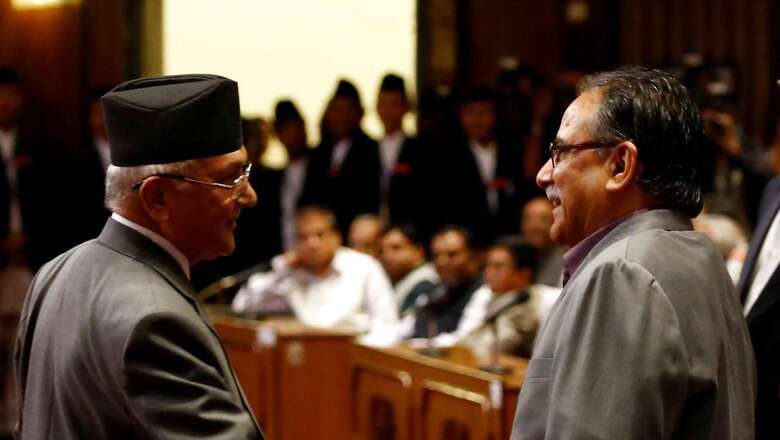
views
The Nepalese democracy has yet again lived up to its image of being unpredictable and somewhat unstable. At the last minute, Pushpa Kamal Dahal “Prachanda” decided to walk out of the alliance with the Nepali Congress (NC) and this meant the end of the road for Sher Bahadur Deuba as far as his present prime ministerial tenure is concerned.
Meanwhile, Prachanda decided to sign a power-sharing deal with his friend-turned-foe former PM Khadga Prasad Sharma Oli. As per the deal, Prachanda will stay in power for the next two and half years, after which he will pass on the mantle to the Communist Party of Nepal (Unified Marxist–Leninist) or UML chief Oli. Prachanda, who himself leads the CPN (Maoist Centre), has facilitated the coming together of Nepal’s Communist parties all over again. For India, this development represents a challenging scenario in the context of its relations with the landlocked Himalayan nation.
Deuba’s ouster comes as a setback for India
For New Delhi, Deuba being ensconced in the Prime Minister’s Office was the best-case scenario. After all the bitterness that was manufactured by the Oli regime during the 2018-2021 tenure, the Deuba government had helped bring India-Nepal ties back on track. The personal proximity between PM Narendra Modi and Deuba was clearly visible when the latter visited India, and the favour was returned when the Indian prime minister visited Lumbini in Nepal.
India was clearly seen as throwing its weight behind the NC-Maoist alliance irrespective of who would get the top post. For New Delhi, the NC-Maoist alliance meant that Kathmandu would remain friendly towards India, even if Prachanda occupied the top post and Deuba-ruled NC played the role of a coalition partner. As per media reports, Deuba had boasted that he enjoyed the “support of both Washington and Delhi” during backroom negotiations. Be that as it may, Deuba seemed like an India-friendly leader in Kathmandu. From New Delhi’s perspective, his presence seemed appropriate both for bolstering traditional Indo-Nepal ties and also for keeping the adverse, leftist elements at bay.
Oli’s shadow over Indo-Nepal ties
Prachanda is an ex-ultra-leftist. Between 1996 and 2006, he led an insurgency movement against the erstwhile Hindu monarchy in Nepal. On top of it, he used to espouse ideological allegiance to the Communist Party of China. Yet, Prachanda is hardly India’s problem. He may have an ultra-leftist background, but he has shown a tendency to understand India’s importance for Kathmandu during his past premiership stints.
It is actually the shadow of Oli’s UML that should get India worried. New Delhi and Kathmandu had suffered a great setback in their bilateral ties back in 2020 when the Oli government started drumming up anti-India propaganda, seemingly at the behest of China. Oli government had then manufactured the Limpiyadhura-Kalapani-Lipulekh territory dispute. In fact, Oli even tried to push through a new map of Nepal, laying claim to over 400 sq km of Indian territory. It is quite likely that Oli could try to use the reunification of the Communist parties in Nepal and his stake in the new government to drum up irredentism and anti-India propaganda.
Moreover, the Chinese have been known to take a keen interest in uniting all Communist outfits in the Himalayan country. The Chinese diplomatic setup too had transgressed the limits of diplomatic relations to shape the Oli government’s anti-India propaganda. Now, it could be looking to use Oli’s renewed influence in Kathmandu to drive a wedge in Indo-Nepal ties all over again.
Former Nepalese Foreign Minister Ramesh Nath Pandey too had echoed the same sentiment. Pandey said, “Past records of present leaders are not encouraging. They created new irritants in the relationship and instead of getting away with unwanted baggage, they added more irritants.”
Challenges and opportunities
With Oli and Prachanda uniting hands, New Delhi is likely to face a challenging situation in Kathmandu. The biggest danger in the present context is the threat of an affirmative Beijing trying to shore up its influence in the landlocked country of Nepal. Ranjit Rae, India’s former ambassador to Nepal, cautioned, “India will have to monitor the developments carefully as China has been trying to unite various factions of Communist parties in the region. We have to keep an eye on it.”
However, it isn’t as if all is lost for India. While Oli is in the thick of things, Prachanda is the Prime Minister of Nepal. So, India can still try to balance out the equations in Kathmandu. Prachanda himself may have a pro-China stance but he does understand the importance of India’s ties with Nepal. This is why he had made it a point to visit India first after taking over as prime minister for a second term in the year 2016. Rae pointed out that “we worked with Prachanda during his previous two terms as prime minister. He visited India recently at the invitation of Bharatiya Janata Party (BJP) President JP Nadda. He understands the significance of India-Nepal relations.”
For New Delhi, it is important to remain invested in Nepal. There will be opportunities in sectors like energy, security and connectivity. Despite any potential friction at the top, Nepal will require India’s assistance in the near future. It is now up to India’s diplomatic establishment to make the most out of the situation that they have at their hands and ensure that the coming together of Oli and Prachanda doesn’t do irreparable damage to bilateral ties.
Akshay Narang is a columnist who writes on national and international affairs. The views expressed in this article are those of the author and do not represent the stand of this publication.
Read all the Latest Opinions here

















Comments
0 comment